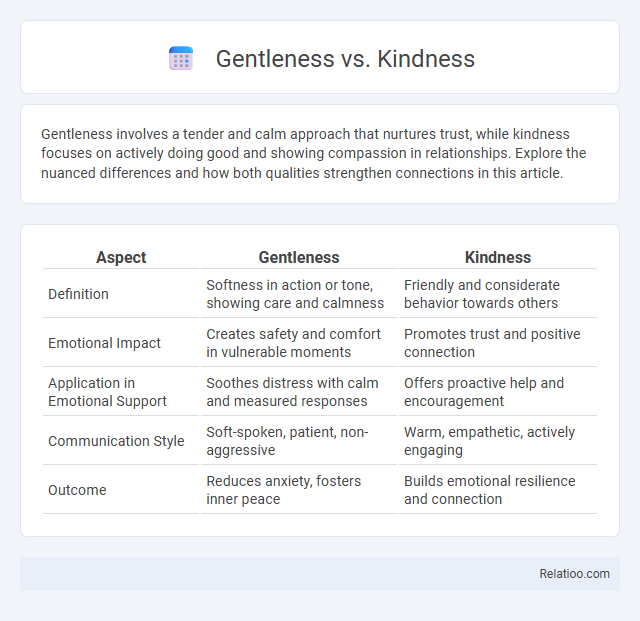Gentleness involves a tender and calm approach that nurtures trust, while kindness focuses on actively doing good and showing compassion in relationships. Explore the nuanced differences and how both qualities strengthen connections in this article.
Table of Comparison
| Aspect | Gentleness | Kindness |
|---|---|---|
| Definition | Softness in action or tone, showing care and calmness | Friendly and considerate behavior towards others |
| Emotional Impact | Creates safety and comfort in vulnerable moments | Promotes trust and positive connection |
| Application in Emotional Support | Soothes distress with calm and measured responses | Offers proactive help and encouragement |
| Communication Style | Soft-spoken, patient, non-aggressive | Warm, empathetic, actively engaging |
| Outcome | Reduces anxiety, fosters inner peace | Builds emotional resilience and connection |
Understanding Gentleness: A Comprehensive Overview
Understanding gentleness involves recognizing it as a calm and tender approach that prioritizes sensitivity and compassion in interactions. Unlike kindness, which emphasizes actions toward others' well-being, gentleness reflects an inner demeanor that influences behavior softly and respectfully. Your ability to practice gentleness fosters trust and comfort, making it a fundamental aspect of empathetic communication and relationships.
The Essence of Kindness: Defining the Core Trait
The essence of kindness lies in its intentional acts of compassion and generosity aimed at improving others' well-being, distinguishing it from gentleness, which emphasizes a soft and calm demeanor, and empathy, centered on understanding others' emotions. Kindness manifests through actionable behaviors such as helping, giving, and comforting, reflecting a deliberate choice to foster positivity and support. This core trait serves as a foundational element in building trust, social bonds, and human connection across diverse contexts.
Key Differences Between Gentleness and Kindness
Gentleness involves a calm and tender approach that minimizes harm, emphasizing softness in action and demeanor, while kindness refers to the genuine desire to help others and promote their well-being through compassionate behavior. Gentleness often reflects how you express kindness, focusing on tone and manner rather than the intent behind the act. Your ability to balance both ensures interactions that are not only well-meaning but also carefully considerate.
The Psychological Impact of Gentleness
Gentleness promotes psychological well-being by fostering a safe emotional environment that reduces stress and anxiety. Unlike kindness, which emphasizes actions toward others, gentleness reflects a mindful attitude that encourages empathy and self-compassion, leading to improved mental health. Scientific studies indicate that practicing gentleness enhances emotional regulation and resilience, contributing to overall psychological balance.
The Social Influence of Kindness
Kindness significantly shapes social interactions by fostering trust, cooperation, and positive community dynamics, distinguishing it from gentleness, which emphasizes softness or calmness in behavior. Your ability to practice kindness enhances social influence, encouraging empathy and reciprocal generosity within groups. This proactive impact on social bonds makes kindness a vital driver of harmonious relationships and collective well-being.
Gentleness in Communication: Building Better Relationships
Gentleness in communication fosters trust and empathy by allowing individuals to express themselves calmly and respectfully, reducing conflict and misunderstanding. Unlike kindness, which often involves acts of generosity, gentleness emphasizes tone, patience, and active listening, creating a safe environment for open dialogue. Incorporating gentleness in conversations enhances emotional connection and strengthens relationships by promoting mutual respect and understanding.
The Role of Kindness in Conflict Resolution
Kindness plays a crucial role in conflict resolution by fostering empathy and understanding between opposing parties, which promotes peaceful dialogue and cooperation. Unlike gentleness, which emphasizes a calm and soft approach, kindness actively involves compassionate actions that acknowledge others' perspectives and needs. Integrating kindness in conflict resolution leads to more sustainable and mutually beneficial outcomes by building trust and reducing hostility.
Cultivating Gentleness: Practical Strategies
Cultivating gentleness involves practicing mindfulness, developing empathy, and engaging in active listening to respond thoughtfully rather than react impulsively. Gentle behavior fosters trust and emotional safety, creating an environment where kindness naturally flourishes. Techniques such as deep breathing, self-reflection, and mindful communication enhance one's ability to embody gentleness consistently in everyday interactions.
Practicing Kindness: Everyday Habits
Practicing kindness as an everyday habit involves intentional actions such as offering genuine compliments, actively listening, and performing small acts of service to others. Gentleness complements kindness by emphasizing a calm, patient, and non-judgmental approach to interactions, reducing stress and fostering trust in relationships. Cultivating both kindness and gentleness can enhance emotional well-being and create a positive social environment through consistent empathetic behavior.
Gentleness vs Kindness: Integrating Both for Personal Growth
Gentleness involves a calm and soothing approach to interactions, emphasizing patience and softness, while kindness centers on active generosity and goodwill towards others. Integrating gentleness with kindness fosters deeper personal growth by balancing compassionate actions with a peaceful demeanor, creating harmonious relationships and emotional resilience. Practicing both qualities enhances empathy, promotes understanding, and nurtures a mindful, positive influence in social and personal contexts.

Infographic: Gentleness vs Kindness
 relatioo.com
relatioo.com